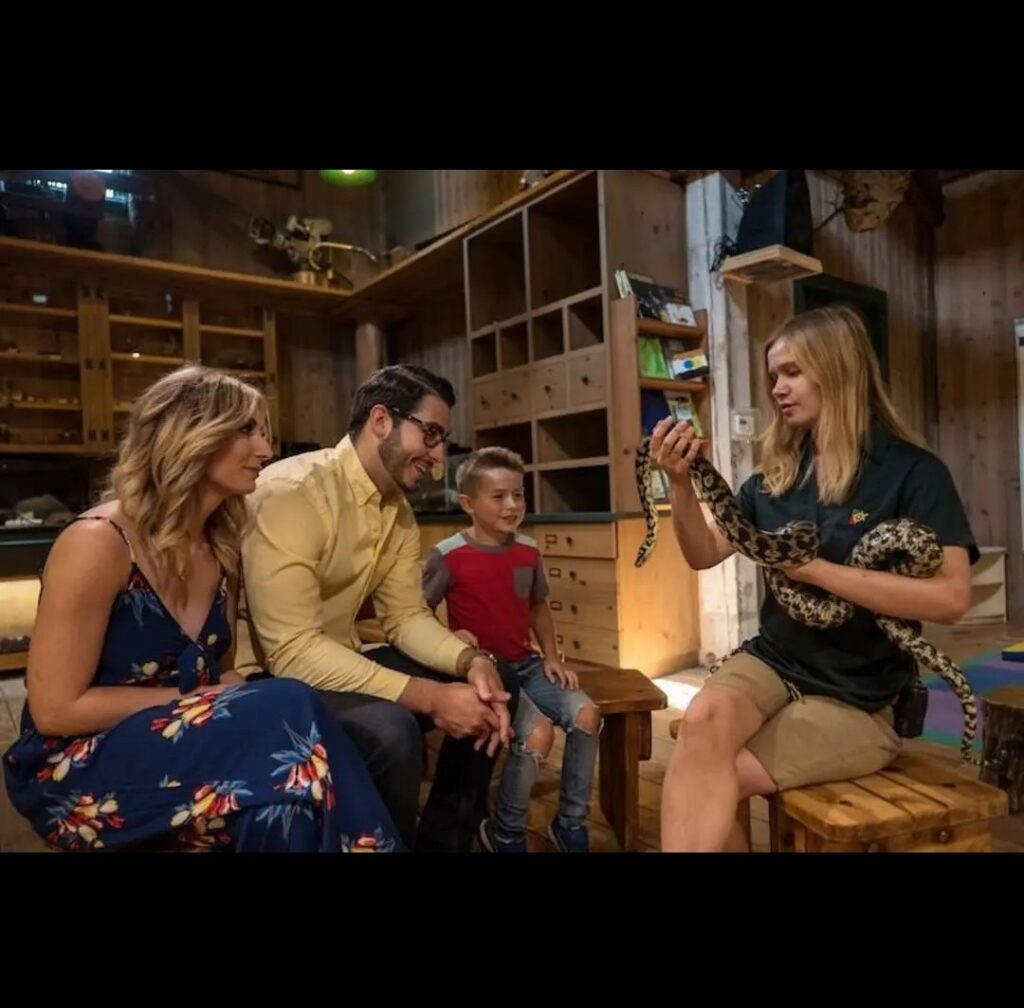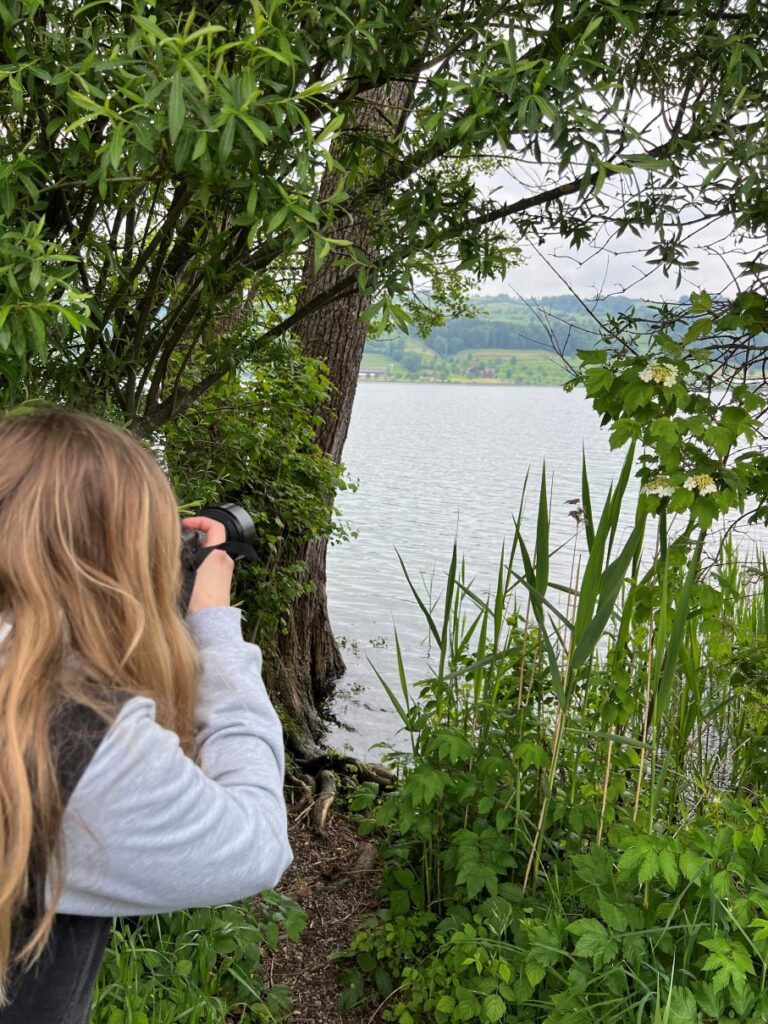Nice to meet you. I’m Sabrina. I was born in Northern California and grew up in a rural area with two Swiss parents. My childhood is what laid the foundation for my two primary interests: biology and languages. These passions are what inspired me to create this website. I decided to start a multilingual blog to merge my interests and discuss topics that fascinate me in various languages. This website serves as a platform to not only enhance my language skills but also to help others with their language-learning journey.
My first exposure to a foreign language was hearing my parents speak Swiss German as a child. They primarily spoke in German to each other but talked to me in English. They did this because my mother was concerned I wouldn’t learn English properly if she spoke to me in German. As my primary parent, she also didn’t want me to pick up any of her bad habits as a non-native speaker, so she enrolled me in school programs as soon as I was old enough. Even though she only spoke to me in German occasionally, I still slowly learned to understand the language, driven by my desire to understand my parents’ conversations and prevent them from talking behind my back. However, while I could understand them when they spoke German, I still struggled to speak the language. Although many people think children effortlessly acquire their parents’ language, learning a language requires time and effort. My parents weren’t able to put in the time it took to teach me properly, so it wasn’t until I began to self-study German at 16 that I could speak more than a few simple sentences.

However, my language journey didn’t start with self-study. My mother attempted to teach me German when I was in elementary school using programs like Rosetta Stone and Pimsleur, but it never stuck. Additionally, I took a year and a half of high school Spanish and learned almost nothing. At the time, I thought languages were difficult and disliked studying them. Eventually, after a summer trip to Switzerland to visit my grandparents, I decided to dedicate a little time to learning German, so I could communicate more easily with my family. I watched YouTube videos such as Learn German with Anya and Easy German and turned the sentences into flashcards. I also began reading in German with my mother. This was the main thing that improved my German. The first book we read together was the German version of Percy Jackson and the Lightning Thief. I would read aloud, and she would correct me. Despite these efforts being sporadic, my understanding of German improved dramatically. Unfortunately, my motivation to invest significant time into learning German was still lacking.
Around this time, I also began taking college classes at the local community college, where I intended to pursue a degree in wildlife biology. Growing up in a rural area, I spent a considerable amount of time outdoors, exploring the forest near my house. I found joy in observing tadpoles in the pond, catching insects, and raising small fish. I frequently borrowed the same field guides from the school library to look at the pictures of animals over and over again. In high school, I began volunteering at the local zoo, where I helped to care for the animals and delivered presentations to the public. My favorite part of volunteering was engaging with the public and educating them about wildlife and the animals we took care of since most of them were rescues that couldn’t be released back into the wild. During one summer, I also received the opportunity to assist with research in Guyana, where we surveyed native wildlife. These experiences helped cement my career path as a biologist.

As I advanced in college, I started working as an English tutor and began to interact more with international students because the English tutor’s desk was right next to the English as a Second Language desk. I quickly found out that a lot of our foreign exchange students came from Japan, and one of my co-workers also worked as a Japanese tutor. At the time, I liked anime, and I had considered learning Japanese because I wanted to understand it, but I thought it would be too difficult to study a language like Japanese. One day my co-worker explained the basics of how Japanese hiragana worked, and I was immediately hooked. I was determined to learn how to read hiragana. I dedicated an entire day to memorizing all the hiragana characters, followed by another day for memorizing all the katakana characters. I also purchased the “Japanese From Zero” textbook and began working my way through it doing two lessons every day and creating flashcards from the sentences and grammar patterns. Japanese became my gateway language, and I quickly made progress, absolutely falling in love with the language.
Eventually, I moved on to using the Genki textbook before switching to native sources. However, this is where my Japanese stagnated. I struggled with the shift to native sources. Despite possessing a substantial vocabulary and a good grasp of grammar, I had difficulty understanding even simple conversations and texts. Reading books in Japanese did not offer the same ease of comprehension as in German. Despite being able to decipher kanji and understand individual words, I struggled to comprehend complete sentences. After about a year of studying Japanese, the Japanese tutor approached me and asked me to take over her role when she graduated that semester. At first, I was hesitant. I had spent a lot of time studying Japanese, but I still couldn’t speak and I’d never taken a Japanese class. However, she assured me that just understanding the basics would be good enough. I would be working with a native Japanese speaker, and I would mostly be there as English support, so I eventually agreed.

When the next semester started, I assumed the role of Japanese tutor. (Coincidentally, this was also the semester I met my partner, who speaks Mandarin Chinese, although I didn’t begin learning Chinese until several years later). However, the experience didn’t unfold as I had anticipated. We had few students, and the tutoring sessions lacked organization. Typically, we would meet once a week in a classroom as a group to discuss Japanese language and culture. While the Japanese exchange student I worked with was enthusiastic about being a tutor, the topics he chose were often uninteresting and text-heavy. I ended up changing the structure of the tutoring session to start with a game before moving on to a reading exercise and speaking practice. The tutoring session quickly became much more popular, and we had a lot more regular students. Our most memorable meeting was when we made sushi for our end-of-semester session. Around half a dozen Japanese exchange students attended, but to our surprise, none of them knew how to make sushi, so one of the American students had to show them how to do it. This moment brought a sense of vindication for me because they had laughed at my chopstick skills.
During this period, I wasn’t studying much Japanese in my free time due to the heavy workload from my classes. Nonetheless, my Japanese still improved through exposure and because I became good friends with one of the Japanese exchange students. I learned a lot from him, and we would occasionally practice speaking Japanese together. However, I still lacked a lot of confidence when speaking. I struggled to make sentences and made a lot of mistakes that at the time I was very self-conscious about but now find funny. For instance, I once mistakenly said, “I like to eat knees” instead of “I like to eat pizza,” and on another occasion, I remarked that “eating children is good for your health.” If I had made another mistake like that, my friend might have started to think I was a cannibal. Unfortunately, a year later, I transferred to a different university to continue my degree in wildlife biology and had to give up my role as a Japanese tutor, but I enjoyed the experience and look back on that time fondly.
As I progressed in my education, I had to set aside my Japanese studies due to the load of my classes. When I finished my wildlife biology degree, I found a job working with predatory mites. Even though I studied birds and mammals during university, I decided to give invertebrates a shot, and three years later, I’m still working with mites. In my free time, I like to go for hikes and photograph birds and mammals, but I will likely continue to focus my professional career on invertebrates. I still really enjoy talking to others about wildlife and other biology topics, so I would also like to work in science communication one day even if it’s on the side.
Once I settled into my new job, I started to have more time to return to languages. I worked in a lab where I was able to listen to podcasts and music most of the day, so I listened to a lot of foreign language content. My Japanese friend, who had moved back to Japan about a year previously, also reached out to me because he wanted to restart our group tutoring sessions online. This motivated me to pick up Japanese once again and continue learning. Although it had been over two years since I had regularly studied Japanese, I was surprised at how much I still knew. I immersed myself by listening to podcasts, watching YouTube, and talking to Japanese people on Conversation Exchange. My Japanese improved faster than ever before, and I could finally have conversations. The first time I spoke for an hour straight with a native speaker was an amazing feeling. It felt like I had finally got somewhere. I was comfortable in the online tutoring sessions we organized and I enjoyed my interactions a lot more than previously. I still had anxiety, but I knew I could talk. Eventually, we stopped doing the online tutoring sessions, and I lost contact with my language exchange partners due to my busy schedule, so it was time to push Japanese to the side and focus on a new language: Mandarin Chinese.

I didn’t initially develop the same passion for Chinese as I did for Japanese. I attempted to learn Chinese multiple times before committing to the language. My first encounter was when my partner tried to teach me how to count. Unfortunately, I struggled to hear or pronounce the tones correctly, and I found it challenging to understand his feedback. As a heritage speaker, he can not read or write, but he speaks very well because his mother doesn’t really speak English. However, it also means he can only understand Chinese if it’s pronounced correctly. He has a very hard time understanding what is said from context if the tones are wrong, so from the beginning, he would correct me a lot. It was very frustrating because I couldn’t tell what I was doing wrong and would have to repeat words over and over again. Pronunciation proved daunting, and the vast number of characters and homophones added to the challenge. Additionally, I doubted whether Chinese media would captivate me, given the strict censorship in China. I tried studying textbooks and apps, I even got a tutor at one point hoping to make some progress, but I would always drop it again after a few weeks.
Once I felt confident in my Japanese skills, I contemplated revisiting Spanish and found myself torn between Spanish and Chinese. Initially, I resumed Spanish, which I hadn’t studied since high school, and on the side, I decided to get some Chinese exposure, so I began watching the TV show “Heaven Offical’s Blessing” on Netflix. After watching the show, which only had one season out at the time, I decided to read the book and from there I was hooked on Chinese media. Now that I knew there was actually media I wanted to consume in Chinese, I was much more motivated to continue learning the language. I used an app called DuShu to learn new words and characters as well as the website Mandarin Bean to learn grammar. I flew through these and soon began reading manhua on Bilibili and watching TV shows like “Keep Running” on YouTube.
Despite a slow start, Chinese gradually became my favorite language. I found its logical characters and simple grammar appealing, and I cherished the diverse expressions and beautiful language. While mastering tones posed a challenge initially, consistent practice and the use of the HanBook app significantly improved my ability. Comparatively, I found Chinese easier than Japanese, primarily due to its straightforward grammar and consistent writing system. It took me about two years to be able to have a conversation in Chinese, whereas it had taken me four years to reach a similar level in Japanese, although different learning techniques definitely played a role in this discrepancy. When I started Chinese I already knew how to learn an Asian language, so the process was much less painful than learning Japanese. Chinese is also a language spoken by over a billion people, many of whom are also interested in learning English, so it is easy to find a conversation partner. In addition to this, Chinese media is not nearly as heavily censored as I thought it would be and it’s easy to access. There is a lot of interesting, high-quality content to consume which makes the process of learning the language fun.

Finally, after reaching a point where I could speak Chinese, I felt I could focus more of my time on Spanish. After two Asian languages, a European language was a nice change of pace. The amount of Spanish I could understand in four months is similar to what took me almost two years to understand in Chinese. I really enjoy the many different cultures and media of the Spanish-speaking countries, and I look forward to what this language brings. I’m currently at an intermediate level and hope to quickly progress to a point where I can speak with my Spanish-speaking co-workers.
When I approach language learning, I always designate one primary focus language, while the others are kept in maintenance mode. For my main language, I ensure daily exposure by listening, reading, and actively studying grammar and vocabulary. As for my passive languages, I rotate through them based on my mood and preferences. For instance, if I want to listen to an educational podcast, I opt for German. If I feel like playing a video game, I switch to Japanese. Integrating language learning into your daily routine is critical. I deliberately avoid using English sources for entertainment because I recognize that time could be better spent gaining valuable input in another language. I only watch English movies when I’m with other people, and I’ve noticed significant improvement using this approach. Although I haven’t actively studied German in years, my proficiency has still improved considerably because I regularly watch and listen to German content.
Time spent immersed in a language is paramount to achieving fluency. Consider how much time you’ve devoted to your native language. How many movies have you watched? How many books have you read? Everything you do in a language contributes to your fluency. I’ve heard many people complain that they just can’t learn a language because they’re too old, children are like sponges that can absorb language. While children may be better when it comes to learning sounds, they aren’t necessarily better at learning a language. They learn through consistent exposure. For example, if a child hears their native language for six hours a day, every day, by age five, they’ve accumulated over 10,000 hours of listening time. With 10,000 hours of input, you’ll undoubtedly speak a language better than a five-year-old child. The difference lies in willingness—children are forced to absorb input, while adults may become frustrated and give up when unable to understand a new language. Persistence and consistency are key to language learning, but it doesn’t have to be boring. Consider all the activities you enjoy in your native language—you can do them in another language too! The most effective learning tools are those that genuinely interest you. Though they may seem distant initially, with the right resources, you can achieve your language goals. I hope you’ve enjoyed learning about my language journey, and I wish you success in yours!

